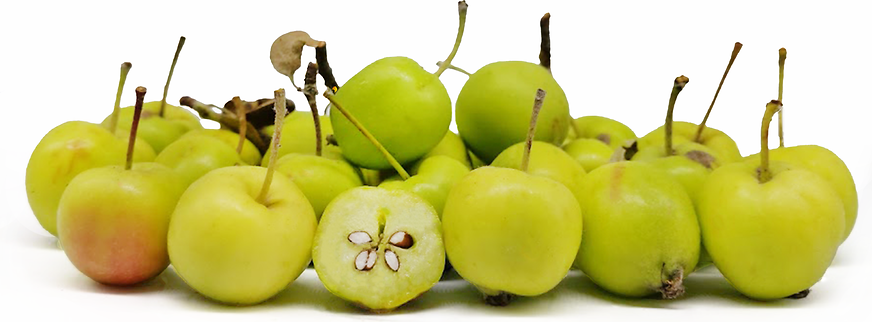


Malus Sieversii Apple
Estimated Inventory, 1 Lb : 0
Description/Taste
Malus sieversii apples are small to medium-sized fruits, averaging 3 to 5 centimeters in diameter and approximately 50 grams in weight, and widely vary in shape from round, conical, ribbed, to flattened. The wild apple species is known for its diverse variation, and there will be many apples with distinct sizes, shapes, and appearances found on a single tree. The apple’s skin typically ripens from green, yellow-green, to golden yellow and is often covered in striped, blurred, and solid red blush patches. The skin is also semi-thin, taut, and smooth. Underneath the surface, the flesh is dense, aqueous, and pale green to yellow with a soft but crisp consistency. Malus sieversii apples range in flavor from sweet to sweet and sour, but most of the apples have a pleasant, somewhat balanced taste. Some apples may have more flavor than others, and some may also have slightly bitter tangy undertones.
Seasons/Availability
Malus sieversii apples are harvested in the early fall.
Current Facts
Malus sieversii apples are a rare, ancient species belonging to the Rosaceae family. The wild apples were discovered in Kazakhstan, naturally growing for thousands of years, and develop on deciduous trees that reach 5 to 12 meters in height. Malus sieversii apples are also known as Sievers apples and are famous among the scientific community as the ancestor to many of the Malus domestica apple varieties sold in modern-day markets. Malus sieversii apple trees are tolerant to extreme temperature fluctuations, have deep roots, and are frost resistant, traditionally used in genomic studies to research and trace the history of apples. The fruits also show extensive genetic diversity on one apple tree, producing apples in different shapes, sizes, colors, and flavors. Despite their genetic importance, most of the wild Malus Sieversii trees have been cut down due to the need for agricultural land expansion and urbanization. Malus sieversii apples are an endangered species, and over 70% of the apple’s native habitat has been destroyed. Scientists worldwide are working to protect these wild trees, and the species has also been added to genetic collections in protected gardens to preserve their genes for future studies.
Nutritional Value
Malus sieversii apples have not been extensively studied for their nutritional properties. Like domestic apples, the species may be a source of vitamin A to maintain healthy organ functioning and vitamin C to increase collagen within the body, strengthen the immune system, and reduce inflammation. The wild apples may also provide fiber to regulate digestion, potassium to balance fluid levels within the body, and other amounts of vitamin B6, manganese, riboflavin, and vitamin K.
Applications
Malus sieversii apples generally have a sweet and sour flavor suited for fresh and cooked preparations. The wild apples can be consumed straight out of hand, discarding the core, or they can be sliced into wedges and served with cheeses and spreads. Malus sieversii apples can also be chopped and added to salads or blended into smoothies. In addition to fresh preparations, Malus sieversii apples can be baked into pies, crumbles, cakes, crisps, muffins, and bread, cooked in browned butter and spices, sauteed and drizzled over ice cream, or fried into fritters. The apples can also be incorporated into soups, roasted as a side dish to meat, or simmered into jams, jellies, and sauces. Beyond traditional dishes, the apples can be dried for extended use, consumed as a chewy snack, or chopped into smaller dried pieces and added to rice dishes. Malus sieversii apples pair well with meats such as beef, pork, and veal, green onions, garlic, carrots, cucumber, red pepper, raisins, nuts, honey, vanilla, and cinnamon. Whole, unwashed Malus Sieversii apples will keep for a few weeks when stored in a cool, dry, and dark location or the refrigerator’s crisper drawer.
Ethnic/Cultural Info
Malus sieversii apples were named after Johann August Carl Sievers, a German botanist who was a part of the Russian Imperial Academy of Sciences in St. Petersburg, Russia. Sievers encountered the wild apples on one of his expeditions to Central Asia in 1796 in a forest in southeastern Kazakhstan. Sievers led the expedition throughout Central Asia and Siberia for over four years and sent 18 letters to St. Petersburg with his observations of the plants he encountered on the trip. Malus sieversii apples were mentioned in his eleventh letter, and Sievers described the apple’s coloring, taste, and texture. Sievers also collected a sample of the Malus Sieversii apple tree, and the specimen is preserved today at the herbarium of the Botanical Institute of St. Petersburg.
Geography/History
Malus sieversii apples are native to Kazakhstan and have been growing wild since ancient times. Experts believe there are approximately 27 species of wild apples, but Malus Sieversii apples are the prominent wild ancestor of domestic apples. Malus sieversii apples were domesticated in Kazakhstan around 3,000 to 4,000 years ago and were spread into China, Western Asia, and Europe through trade along the Silk Road. Over time, Malus sieversii apples continued to expand in cultivation and were known throughout Europe by the mid-19th century. The variety contributed to the creation of many of the apple varieties present in the world in the modern-day, and in the 1930s, several scientists began to document and trace the origins of apples. Nikolai Vavilov, a Russian biologist, spearheaded the research project, and his student Aimak Dzhangaliev continued the study, eventually helping to preserve the Sievers apple from extinction. Today Malus Sieversii apples are considered endangered, and efforts are being made to protect the wild species. Malus sieversii apple trees are found in the foothills and mountains throughout Kazakhstan in Altai, Tarbagatai, Talas, Kirghiz, Dzungarian, Zailiysky, Ketmentau, Karatau, and Kungei Alatau.




